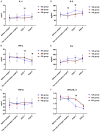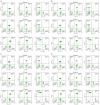Effect of different anaesthesia methods on perioperative cellular immune function and long-term outcome in patients undergoing radical resection of esophageal cancer: a prospective cohort study
- PMID: 34786069
- PMCID: PMC8581899
Effect of different anaesthesia methods on perioperative cellular immune function and long-term outcome in patients undergoing radical resection of esophageal cancer: a prospective cohort study
Abstract
To analyze the effects of different anaesthetic methods on perioperative cellular immunity and long-term outcome in patients who undergo esophageal cancer surgery.
Participants: A total of 120 patients with esophageal cancer admitted to Zhengzhou University People's Hospital from January 2016 to January 2017 were recruited and randomly divided into a GA group (general anaesthesia, n = 40), a PG group (paravertebral nerve block with general anaesthesia, n = 40) and an EG group (epidural anaesthesia with general anaesthesia, n = 40).
Methods: Self-rating anxiety scale and visual analogue scale scores were adopted to compare postoperative anxiety and the degree of pain of patients in the three groups. In addition, the adverse reactions of patients in the three groups were compared. The levels of interleukin-6 (IL-6), IL-4, tumor necrosis factor-α (TNF-α), interferon-γ (IFN-γ), and the survival of T-cell subsets (CD3+, CD4+, CD8+, CD4+/CD8+) before operation, at the end of operation, and on postoperative day (POD) 1 and POD 2 were measured by either ELISA or flow cytometry.
Results: In the PG and EG group, the VAS scores were lower, and fewer opioids and vasoactive agents were used than in the GA group. In both the EG and PG groups, higher CD3+ and CD4+ cell survival and lower levels of Cor, IL-4, and IL-6 were identified at the end of or after the surgery than in the GA group. Moreover, the postoperative survival curves of the PG and EG groups were better than that of the GA group.
Conclusions: The combination of paravertebral nerve block or epidural anaesthesia and general anaesthesia may improve perioperative immune function and long-term outcome in patients who undergo esophageal cancer surgery.
Keywords: Cellular immunity; cytokinesis; epidural block; esophageal cancer; long-term follow-up; paravertebral block.
AJTR Copyright © 2021.
Conflict of interest statement
None.
Figures





Similar articles
-
The effects of epidural anaesthesia and analgesia on T lymphocytes differentiation markers and cytokines in patients after gastric cancer resection.BMC Anesthesiol. 2019 Jun 12;19(1):102. doi: 10.1186/s12871-019-0778-7. BMC Anesthesiol. 2019. PMID: 31185917 Free PMC article. Clinical Trial.
-
Comparison of the effects of sufentanil-dominant anaesthesia/analgesia and epidural anaesthesia/analgesia on postoperative immunological alterations, stress responses and prognosis in open hepatectomy: a randomized trial.J Gastrointest Oncol. 2023 Dec 31;14(6):2521-2535. doi: 10.21037/jgo-23-711. Epub 2023 Nov 15. J Gastrointest Oncol. 2023. PMID: 38196520 Free PMC article.
-
Effects of different anesthesia and analgesia on cellular immunity and cognitive function of patients after surgery for esophageal cancer.Minerva Chir. 2020 Dec;75(6):449-456. doi: 10.23736/S0026-4733.20.08283-8. Epub 2020 Aug 6. Minerva Chir. 2020. PMID: 32773737 Clinical Trial.
-
The Immunomodulatory Effect of Various Anaesthetic Practices in Patients Undergoing Gastric or Colon Cancer Surgery: A Systematic Review and Meta-Analysis of Randomized Clinical Trials.J Clin Med. 2023 Sep 18;12(18):6027. doi: 10.3390/jcm12186027. J Clin Med. 2023. PMID: 37762967 Free PMC article. Review.
-
Perioperative local anaesthesia for reducing pain following septal surgery.Cochrane Database Syst Rev. 2018 Aug 23;8(8):CD012047. doi: 10.1002/14651858.CD012047.pub2. Cochrane Database Syst Rev. 2018. PMID: 30136717 Free PMC article.
Cited by
-
Effect of surgical pleth index-guided remifentanil administration on perioperative outcomes in elderly patients: a prospective randomized controlled trial.BMC Anesthesiol. 2023 Feb 17;23(1):57. doi: 10.1186/s12871-023-02011-5. BMC Anesthesiol. 2023. PMID: 36803564 Free PMC article. Clinical Trial.
-
Tumor Necrosis Factor Alpha: Implications of Anesthesia on Cancers.Cancers (Basel). 2023 Jan 25;15(3):739. doi: 10.3390/cancers15030739. Cancers (Basel). 2023. PMID: 36765695 Free PMC article. Review.
-
Opioid-free anesthesia attenuates perioperative immunosuppression by regulating macrophages polarization in gastric cancer patients treated with neoadjuvant PD-1 inhibitor.Front Immunol. 2024 Sep 23;15:1438859. doi: 10.3389/fimmu.2024.1438859. eCollection 2024. Front Immunol. 2024. PMID: 39430763 Free PMC article.
-
Combined General/Epidural Anesthesia vs. General Anesthesia on Postoperative Cytokines: A Review and Meta-Analysis.Cancers (Basel). 2025 May 15;17(10):1667. doi: 10.3390/cancers17101667. Cancers (Basel). 2025. PMID: 40427164 Free PMC article. Review.
-
Effects of different anesthesia methods on postoperative immune function in patients undergoing gastrointestinal tumor resection.Sci Rep. 2023 Jan 5;13(1):243. doi: 10.1038/s41598-023-27499-2. Sci Rep. 2023. PMID: 36604521 Free PMC article.
References
-
- Jemal A, Bray F, Center MM, Ferlay J, Ward E, Forman D. Global cancer statistics. CA Cancer J Clin. 2011;61:69–90. - PubMed
-
- Kurosawa S. Anesthesia in patients with cancer disorders. Curr Opin Anaesthesiol. 2012;25:376–384. - PubMed
-
- Lindholm ML, Granath F, Eriksson LI, Sandin R. Malignant disease within 5 years after surgery in relation to duration of sevoflurane anesthesia and time with bispectral index under 45. Anesth Analg. 2011;113:778–783. - PubMed
-
- Sun Y, Li T, Gan TJ. The effects of perioperative regional anesthesia and analgesia on cancer recurrence and survival after oncology surgery: a systematic review and meta-analysis. Reg Anesth Pain Med. 2015;40:589–598. - PubMed
LinkOut - more resources
Full Text Sources
Research Materials
